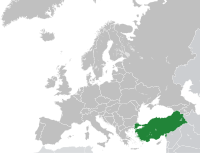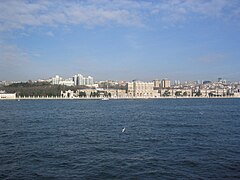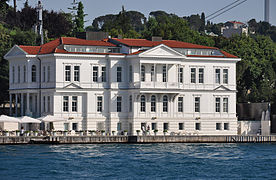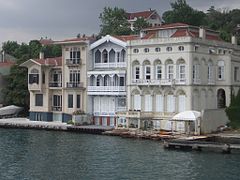Bosporus




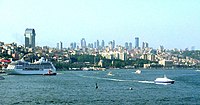

The Bosphorus (/ˈbɒsfərəs/) or Bosporus (/ˈbɒspərəs/; Template:Lang-grc, Bósporos; Template:Lang-tr, pronounced [boːaziˈt͡ʃi]) is a natural strait and internationally-significant waterway located in northwestern Turkey that forms part of the continental boundary between Europe and Asia, and separates Asian Turkey from European Turkey. The world's narrowest strait used for international navigation, the Bosporus connects the Black Sea with the Sea of Marmara, and, by extension via the Dardanelles, the Aegean and Mediterranean Seas.
Most of the shores of the strait are heavily settled, straddled by the city of Istanbul's metropolitan population of 17 million inhabitants extending inland from both coasts.
Together with the Dardanelles (Hellespont) strait, the Bosphorus forms the Turkish Straits.
Name
The original name of the channel comes from an Anglicization of the Ancient Greek Βόσπορος (Bosporos), which was folk-etymologized[citation needed] as βοὸς πόρος, i.e. "cattle strait" (or "Ox-ford"[1]), from the genitive of bous βοῦς "ox, cattle" + poros πόρος "passage", thus meaning "cattle-passage", or "cow passage".[2] This is in reference to the mythological story of Io, who was transformed into a cow, and was subsequently condemned to wander the Earth until she crossed the Bosphorus, where she met the Titan Prometheus, who comforted Io with the information that she would be restored to human form by Zeus and become the ancestress of the greatest of all heroes, Heracles (Hercules).
This folk etymology was canonized by Aeschylus in Prometheus Bound (v. 734f.), where Prometheus prophesies to Io that the strait would be named after her. The site where Io supposedly went ashore was near Chrysopolis (present-day Üsküdar), and was named Bous "the Cow". The same site was also known as Damalis, as it was where the Athenian general Chares had erected a monument to his wife Damalis, which included a colossal statue of a cow (the name Damalis translating to "calf").[3]
The spelling with -ph-, as Bosphorus, has no justification in the ancient Greek name, but it occurs as a variant in medieval Latin (as Bosphorus, and occasionally Bosforus, Bosferus), and in medieval Greek sometimes as Βόσφορος,[4] giving rise to the French form Bosphore, Spanish Bósforo, and Russian Босфор. The 12th-century Greek scholar John Tzetzes calls it Damaliten Bosporon (after Damalis), but he also reports that in popular usage the strait was known as Prosphorion during his day,[5] the name of the most ancient northern harbour of Constantinople.
Historically, the Bosphorus was also known as the "Strait of Constantinople", or the Thracian Bosphorus, in order to distinguish it from the Cimmerian Bosporus in Crimea. These are expressed in Herodotus' Histories, 4.83; as Bosporus Thracius, Bosporus Thraciae , and Βόσπορος Θρᾴκιος, respectively. Other names by which the strait is referenced by Herodotus include Chalcedonian Bosporus (Bosporus Chalcedoniae, Bosporos tes Khalkedonies, Herodotus 4.87), or Mysian Bosporus (Bosporus Mysius).[6]
The term eventually came to be used as common noun βόσπορος, meaning "a strait", and was also formerly applied to the Hellespont in Classical Greek by Aeschylus and Sophocles.
Presently, the waterway is officially referred to as simply "Bosphorus" (Template:Lang-tr), the "Strait of Istanbul", or "Istanbul Strait" (Template:Lang-tr).
Geography
As a maritime waterway, the Bosphorus connects various seas along the Eastern Mediterranean, the Balkans, the Near East, and Western Eurasia, and specifically connects the Black Sea to the Sea of Marmara. The Marmara further connects to the Aegean and Mediterranean Seas via the Dardanelles. Thus, the Bosphorus allows maritime connections from the Black Sea all the way to the Mediterranean Sea and the Atlantic Ocean via Gibraltar, and the Indian Ocean through the Suez Canal, making it a crucial international waterway, in particular for the passage of goods coming in from Russia.
A common mistake often made by foreigners is to assume the Bosphorus is a river, when it is, in fact, a narrow sea channel.
Formation
The exact scientific cause for the formation of the Bosphorus remains the subject of debate among geologists. One of the more prominent theories, dubbed The Black Sea deluge theory, which was reinforced in credibility by a study of the same name in 1997 by two scientists from Columbia University, contends that the Bosphorus was formed in circa 5600 BCE when the rising waters of the Mediterranean Sea and the Sea of Marmara breached through to the Black Sea, which at the time, according to the theory, was a low-lying body of fresh water.
From the perspective of ancient Greek mythology, it was said that colossal floating rocks known as the Symplegades, or Clashing Rocks, once occupied the hilltops on both sides of the Bosphorus, and destroyed any ship that attempted passage of the channel by rolling down the strait's hills and violently crushing all vessels between them. The Symplegades were defeated when the lyrical hero Jason obtained successful passage, whereupon the rocks became fixed, and Greek access to the Black Sea was opened.
Present morphology
The limits of the Bosphorus are defined as the connecting line between the lighthouses of Rumeli Feneri and Anadolu Feneri in the north, and between the Ahırkapı Feneri and the Kadıköy İnciburnu Feneri in the south. Between these limits, the strait is 31 km (17 nmi) long, with a width of 3,329 m (1.798 nmi) at the northern entrance and 2,826 m (1.526 nmi) at the southern entrance. Its maximum width is 3,420 m (1.85 nmi) between Umuryeri and Büyükdere Limanı, and minimum width 700 m (0.38 nmi) between Kandilli Point and Aşiyan.
The depth of the Bosphorus varies from 13 to 110 m (43 to 361 ft) in midstream with an average of 65 m (213 ft). The deepest location is between Kandilli and Bebek with 110 m (360 ft). The most shallow locations are off Kadıköy İnciburnu on the northward route with 18 m (59 ft) and off Aşiyan Point on the southward route with 13 m (43 ft).[7]
The Golden Horn is an estuary off the main strait that historically acted as a moat to protect Old Istanbul from attack, as well as providing a sheltered anchorage for the imperial navies of various empires until the 19th century, after which it became a historic neighborhood at the heart of the city, popular with tourists and locals alike.
Newer explorations
It had been known since before the 20th century that the Black Sea and the Sea of Marmara flow into each other in a geographic example of "density flow", and in August 2010, a continuous 'underwater channel' of suspension composition was discovered to flow along the floor of the Bosphorus, which would be the sixth largest river on Earth if it were to be on land. The study of the water and wind erosion of the straits relates to that of its formation. Sections of the shore have been reinforced with concrete or rubble and sections of the strait prone to deposition are periodically dredged.
The 2010 team of scientists, led by the University of Leeds, used a robotic "yellow submarine" to observe detailed flows within an "undersea river", scientifically-referred-to as a submarine channel, for the first time. Submarine channels are similar to land rivers, but they are formed by density currents—underwater flow mixtures of sand, mud and water that are denser than sea water and so sink and flow along the bottom. These channels are the main transport pathway for sediments to the deep sea where they form sedimentary deposits. These deposits ultimately hold not only untapped reserves of gas and oil, they also house important secrets—from clues on past climate change to the ways in which mountains were formed.[8]
The team studied the detailed flow within these channels and findings included:
The channel complex and the density flow provide the ideal natural laboratory for investigating and detailing the structure of the flow field through the channel. Our initial findings show that the flow in these channels is quite different to the flow in river channels on land. Specifically, as flow moves around a bend it spirals in the opposite direction in the deep sea compared to the spiral to that found in river channels on land. This is important in understanding the sedimentology and layers of sediment deposited by these systems.[9]
The central tenet of the Black Sea deluge theory is that as the ocean rose 72.5 metres (238 ft) at the end of the last Ice Age when the massive ice sheets melted, the sealed Bosphorus was overtopped in a spectacular flood that increased the then fresh water Black Sea Lake 50%, and drove people from the shores for many months. This was proven by undersea explorer Robert Ballard, who discovered settlements along the old shoreline; scientists dated the Flood to 7500 BP or 5500 BC from fresh-salt water microflora. The peoples driven out by the constantly rising water, which must have been terrifying and inexplicable, spread to all corners of the Western world carrying the story of the Great Flood, how it probably entered most religions. As the waters surged, they scoured a network of sea-floor channels less resistant to denser suspended solids in liquid, which remains a very active layer today.
The first images of these submarine channels were obtained in 1999, showing them to be of great size[10] during a NATO SACLANT Undersea Research project using jointly the NATO RV Alliance, and the Turkish Navy survey ship Çubuklu. In 2002, a survey was carried out on board the Ifremer RV Le Suroit for BlaSON project (Lericolais, et al., 2003[11]) completed the multibeam mapping of this underwater channel fan-delta. A complete map was published in 2009 [12] using these previous results with high quality mapping obtained in 2006 (by researchers at Memorial University, Newfoundland, Canada who are project partners in this study.)
The team will use the data obtained to create innovative computer simulations that can be used to model how sediment flows through these channels. The models the team will produce will have broad applications, including inputting into the design of seafloor engineering by oil and gas companies.
The project was led by Dr. Jeff Peakall and Dr. Daniel Parsons at the University of Leeds, in collaboration with the University of Southampton, Memorial University (Newfoundland, Canada), and the Institute of Marine Sciences (Izmir, Turkey). The survey was run and coordinated from the Institute of Marine Sciences research ship, the R/V Koca Piri Reis.
The researchers estimate that the river, known as a submarine channel, would be the sixth largest river in the world if it were on land based on the amount of water flowing through it.[13]
History
As part of the only passage between the Black Sea and the Mediterranean, the Bosphorus has always been of great importance from a commercial and military point of view, and remains strategically important today. It is a major sea access route for numerous countries, including Russia and Ukraine. Control over it has been an objective of a number of conflicts in modern history, notably the Russo-Turkish War (1877–78), as well as of the attack of the Allied Powers on the Dardanelles during the 1915 Battle of Gallipoli in the course of World War I.
Ancient Greek, Persian, Roman, and Byzantine Eras (pre-1453)

The strategic importance of the Bosphorus dates back millennia. The Greek city-state of Athens in the 5th century BC, which was dependent on grain imports from Scythia, maintained critical alliances with cities which controlled the straits, such as the Megarian colony Byzantium.
Persian King Darius I the Great, in an attempt to subdue the Scythian horsemen who roamed across the north of the Black Sea, crossed through the Bosphorus, then marched towards the Danube River. His army crossed the Bosphorus over an enormous bridge made by connecting Achaemenid boats.[14] This bridge essentially connected the farthest geographic tip of Asia to Europe, encompassing at least some 1000 meters of open water if not more.[15] Years later, a similar boat bridge would be constructed by Xerxes I on the Dardanelles (Hellespont) strait, during his invasion of Greece.
The Byzantines called the Bosphorus "Stenon" and most important toponyms of it Bosporios Akra, Argyropolis, St. Mamas, St. Phokas, Hestiai or Michaelion, Phoneus, Anaplous or Sosthenion in European side and Hieron tower, Eirenaion, Anthemiou, Sophianai, Bithynian Chryspolis in Asian side in this era [16]
The strategic significance of the strait was one of the factors in the decision of the Roman Emperor Constantine the Great to found there in AD 330 his new capital, Constantinople, which came to be known as the capital of the Eastern Roman Empire. The phrase "swim the Bosphorus" or "crossing the Bosphorus" was, and is still used to indicate religious conversion to the Eastern Orthodox Church.
Ottoman Era (1453-1922)

On 29 May 1453, Constantinople was conquered by the Ottoman Empire. In fact, as the Ottoman Turks closed in on Constantinople, they constructed a fortification on each side of the strait, Anadoluhisarı (1393) and Rumelihisarı (1451).
At its peak in the 16th through the 18th centuries, the Ottoman Empire had wrested control of the entire Black Sea area, which was for the time an "Ottoman lake", on which Russian warships were prohibited.[17]
Subsequently, several international treaties have governed vessels using the waters. Under the Treaty of Hünkâr İskelesi of July 8, 1833, the Bosporus and Dardanelles straits were to be closed on Russian demand to naval vessels of other powers.[18] By the terms of the London Straits Convention concluded on July 13, 1841, between the Great Powers of Europe — Russia, the United Kingdom, France, Austria and Prussia — the "ancient rule" of the Ottoman Empire was re-established by closing the Turkish Straits to any and all warships, barring those of the Sultan's allies during wartime. It thus benefited British naval power at the expense of Russian, as the latter lacked direct access for its navy to the Mediterranean.[19]
Following World War I, the 1920 Treaty of Sèvres demilitarized the strait and made it an international territory under the control of the League of Nations.
Turkish Republican and Modern Eras (1923-present)
This was amended under the 1923 Treaty of Lausanne, which restored the straits to Turkish territory—but allowed all foreign warships and commercial shipping to traverse the straits freely. Turkey eventually rejected the terms of that treaty, and subsequently Turkey remilitarized the straits area. The reversion was formalized under the Montreux Convention Regarding the Regime of the Turkish Straits of July 20, 1936. That convention, which is still in force, treats the straits as an international shipping lane save that Turkey retains the right to restrict the naval traffic of non-Black Sea states.
Turkey was neutral in World War II until February 1945, and the straits were closed to the warships of belligerent nations during this time, although some German auxiliary vessels were permitted to transit. In diplomatic conferences, Soviet representatives had made known their interest in Turkish concession of Soviet naval bases on the straits. This, as well as Stalin's demands for the restitution of the Turkish provinces of Kars, Artvin and Ardahan to the Soviet Union (which were lost by Turkey in the Russo–Turkish War of 1877–1878, but were regained with the Treaty of Kars in 1921), were considerations in Turkey's decision to abandon neutrality in foreign affairs. Turkey declared war against Germany in February 1945, but did not engage in offensive actions.[20][21][22][23]
Turkey joined NATO in 1952, thus affording its straits even more strategic importance as a commercial and military waterway.
In more recent years, the Turkish Straits have become particularly important for the oil industry. Russian oil, from ports such as Novorossyisk, is exported by tankers primarily to western Europe and the U.S. via the Bosphorus and the Dardanelles straits. In 2011 Turkey planned a 50 km canal through Silivri as a second waterway, reducing risk in the Bosphorus.[24][25]
Crossings

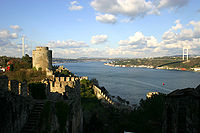

Maritime
The waters of the Bosphorus are traversed by numerous passenger and vehicular ferries daily, as well as recreational and fishing boats ranging from dinghies to yachts owned by both public and private entities.
The strait also experiences significant amounts of international commercial shipping traffic by freighters and tankers. Between its northern limits at Rumeli Feneri and Anadolu Feneri and its southern ones at Ahırkapı Feneri and Kadıköy İnciburnu Feneri, there are numerous dangerous points for large-scale maritime traffic that require sharp turns and management of visual obstructions. Famously, the stretch between Kandilli Point and Aşiyan requires a 45-degree course alteration in a location where the currents can reach 7 to 8 knots (3.6 to 4.1 m/s). To the south, at Yeniköy, the necessary course alteration is 80 degrees. Compounding these difficult changes in trajectory, the rear and forward sights at Kandilli and Yeniköy are also completely blocked prior to and during the course alteration, making it impossible for ships approaching from the opposite direction to see around these bends. The risks posed by geography are further multiplied by the heavy ferry traffic across the strait, linking the European and Asian sides of the city. As such, all the dangers and obstacles characteristic of narrow waterways are present and acute in this critical sea lane.
In 2011, the Turkish Government discussed creating a large-scale canal project roughly 80 kilometres (50 mi) long that runs north-south through the western edges of Istanbul Province as a second waterway between the Black Sea and the Marmara, intended to reduce risk in the Bosphorus.[26][27] The project currently continues being debated.
Land
Two suspension bridges cross the Bosphorus. The first of these, the Bosporus Bridge, is 1,074 m (3,524 ft) long and was completed in 1973. The second, named Fatih Sultan Mehmet (Bosphorus II) Bridge, is 1,090 m (3,576 ft) long, and was completed in 1988 about 5 km (3 mi) north of the first bridge. The Bosphorus Bridge forms part of the O1 Motorway, while the Fatih Sultan Mehmet Bridge forms part of the Trans-European Motorway.
Construction of a third suspension bridge, the Yavuz Sultan Selim Bridge, began on May 29, 2013; opening is planned for mid-2016.[28] The bridge will be built near the northern end of the Bosphorus, between the villages of Garipçe on the European side and Poyrazköy on the Asian side.[29] It will be part of the "Northern Marmara Motorway", which will be further integrated with the existing Black Sea Coastal Highway, and will allow transit traffic to bypass city traffic.
Submarine
The Marmaray project, featuring a 13.7 km (8.5 mi) long undersea railway tunnel, opened on 29 October 2013.[30] Approximately 1,400 m (4,593 ft) of the tunnel runs under the strait, at a depth of about 55 m (180 ft).
An undersea water supply tunnel with a length of 5,551 m (18,212 ft),[31] named the Bosporus Water Tunnel, was constructed in 2012 to transfer water from the Melen Creek in Düzce Province (to the east of the Bosphorus strait, in northwestern Anatolia) to the European side of Istanbul, a distance of 185 km (115 mi).[31][32]
The Eurasia Tunnel is a road tunnel between Kazlıçeşme and Göztepe, which began construction in February 2011 and is expected to open in 2016.
Sightseeing
The Bosphorus has 620 waterfront houses (yalı) built during the Ottoman period along the strait's European and Asian shorelines. Ottoman palaces such as the Topkapı Palace, Dolmabahçe Palace, Yıldız Palace, Çırağan Palace, Feriye Palaces, Beylerbeyi Palace, Küçüksu Palace, Ihlamur Palace, Hatice Sultan Palace, Adile Sultan Palace and Khedive Palace are within its view. Buildings and landmarks within view include the Hagia Sophia, Hagia Irene, Sultan Ahmed Mosque, Yeni Mosque, Kılıç Ali Pasha Mosque, Nusretiye Mosque, Dolmabahçe Mosque, Ortaköy Mosque, Üsküdar Mihrimah Sultan Mosque, Yeni Valide Mosque, Maiden's Tower, Galata Tower, Rumelian Castle, Anatolian Castle, Yoros Castle, Selimiye Barracks, Sakıp Sabancı Museum, Sadberk Hanım Museum, Istanbul Museum of Modern Art, Borusan Museum of Contemporary Art, Tophane-i Amire Museum, Mimar Sinan Fine Arts University, Galatasaray University, Boğaziçi University, Robert College, Kabataş High School, Kuleli Military High School.
Two points in Istanbul have most of the public ferries that traverse the strait: from Eminönü (ferries dock at the Boğaz İskelesi pier) on the historic peninsula of Istanbul to Anadolu Kavağı near the Black Sea, zigzagging and calling briefly multiple times at the Rumelian and Anatolian sides of the city. At central piers shorter, regular ride in one of the public ferries cross.
Private ferries operate between Üsküdar and Beşiktaş or Kabataş in the city. The few well-known geographic hazards are multiplied by ferry traffic across the strait, linking the European and Asian sides of the city, particularly for the largest ships.[7]
The catamaran seabuses offer high-speed commuter services between the European and Asian shores of the Bosphorus, but they stop at fewer ports and piers in comparison to the public ferries. Both the public ferries and the seabuses also provide commuter services between the Bosphorus and the Prince Islands in the Sea of Marmara.
There are also tourist rides available in various places along the coasts of the Bosphorus. The prices vary according to the type of the ride, and some feature loud popular music for the duration of the trip.
Image gallery
-
View of the European side of Istanbul from the southern entrance to the Bosphorus.
-
View of the European side of Istanbul from the Bosphorus.
-
View of the entrance to the Bosphorus from the Sea of Marmara, as seen from the Topkapı Palace.
-
Panoramic view of the Bosphorus as seen from Ulus on the European side, with the Fatih Sultan Mehmet Bridge (1988) at left and the Bosphorus Bridge (1973) at right.
-
Fatih Sultan Mehmet Bridge (1988) and the Bosphorus strait.
-
Dolmabahçe Palace on the Bosphorus.
-
View from Topkapi Palace on the Bosphorus.
-
View of the Bosphorus from the Marmara Hotel, Taksim Square.
-
The Rumelian Castle on the Bosphorus, with both suspension bridges which span the strait.
-
620 historic waterfront houses stretch along the coasts of the Bosphorus, such as the yalı of Ahmet Rasim Pasha.
-
Yalı of Hacı Şefik Bey on the Bosphorus.
-
Ottoman era waterfront houses on the Bosphorus.
-
Afif Pasha Mansion on the Bosphorus was designed by Alexander Vallaury.
-
The quarters of Bebek, Arnavutköy and Yeniköy on the Bosphorus are famous for their fish restaurants.
-
Ottoman era waterfront houses (yalı) on the Bosphorus.
-
Ottoman era waterfront houses (yalı) on the Bosphorus.
-
Ottoman era waterfront houses (yalı) on the Bosphorus.
See also
- Bosphorus Bridge, also called the First Bosphorus Bridge.
- Fatih Sultan Mehmet Bridge, also called the Second Bosphorus Bridge, located about 5 km north of the Bosphorus Bridge.
- Yavuz Sultan Selim Bridge, also called the Third Bosphorus Bridge, currently under construction.
- Eurasia Tunnel, undersea tunnel, crossing the Bosphorus for vehicular traffic, currently under construction.
- Marmaray, undersea rail tunnel, crossing the Bosphorus and connecting the Asian and European sides of Istanbul.
- Public transport in Istanbul
- Rail transport in Turkey
- Turkish Straits
- List of maritime incidents in the Turkish Straits
Notes
- ^ there is a certain (Oxonian) tradition of equating the name "Oxford" with "Bosporus", see e.g. Wolstenholme Parr, Memoir on the propriety of the word Oxford, Oxford,1820, esp. p. 18
- ^ Entry: Βόσπορος at Henry George Liddell, Robert Scott, 1940, A Greek-English Lexicon.
- ^ F. Sickler, Handbuch der alten Geographie, 1824, p. 551.
- ^ Bosporus inCharlton T. Lewis, Charles Short, A Latin Dictionary (1879).
- ^ Carl Müller, Geographi graeci minores, Didot, 1861, p. 7.
- ^ Friedrich Heinrich Theodor Bischoff, Verleichendes wörterbuch der alten, mittleren und neuen geographie, Becker, 1829, 195f.
- ^ a b "Türk Boğazları ve Marmara Denizi'nin Coğrafi Konumu-İstanbul Boğazı" (in Turkish). Denizcilik. Archived from the original on 8 October 2011. Retrieved 2010-09-18.
{{cite web}}: Unknown parameter|deadurl=ignored (|url-status=suggested) (help) - ^ Leeds researchers study undersea rivers with a yellow submarine AUVAC, 2010
- ^ Futurity.org: "Robotic sub. records flow of undersea river" (August 2, 2010.)
- ^ Di Iorio, D., and Yüce, H. (1999). Observations of Mediterranean flow into the Black Sea. Journal of Geophysical Research 104(C2), 3091-3108.
- ^ Lericolais, G., Le Drezen, E., Nouzé, H., Gillet, H., Ergun, M., Cifci, G., Avci, M., Dondurur, D., and Okay, S. (2002). Recent canyon heads evidenced at the Bosporus outlet. EOS transactions, AGU Fall Meet. Suppl. 83(47), Abstract PP71B-0409.
- ^ Flood, R. D., Hiscott, R. N., and Aksu, A. E. (2009). Morphology and evolution of an anastomosed channel network where saline underflow enters the Black Sea. Sedimentology 56(3), 807-839.
- ^ "University of Leeds". Leeds.ac.uk. Retrieved 2016-01-31.
- ^ Polybios, Historiae IV, 39, 16; Özhan Öztürk. Pontus: Antik Çağ’dan Günümüze Karadeniz’in Etnik ve Siyasi Tarihi Genesis Yayınları. Ankara, 2011 pp. 28–29
- ^ Herodotus (Translation by George Rawlinson, Sir Henry Creswicke Rawlinson, Sir John Gardner Wilkinson) (1859). The History of Herodotus: a new English version, Volume 3. John Murray. pp. 77 (Chp. 86).
{{cite book}}: CS1 maint: multiple names: authors list (link) - ^ Özhan Öztürk. Pontus: Antik Çağ’dan Günümüze Karadeniz’in Etnik ve Siyasi Tarihi Genesis Yayınları. Ankara, 2011 pp. 28–32
- ^ "Turkey - Köprülü Era". Workmall.com. 2007-03-24. Retrieved 2010-06-08.
- ^ "Turkey - External Threats and Internal Transformations". Workmall.com. 2007-03-24. Retrieved 2010-06-08.
- ^ Christos L. Rozakis (1987). The Turkish Straits. Martinus Nijhoff Publishers. pp. 24–25.
- ^ "Foreign Policy Research Institute: The Turkish Factor in the Geopolitics of the Post-Soviet Space (Igor Torbakov)". Fpri.org. 2003-01-10. Retrieved 2010-06-08.
- ^ "Turkish-Soviet Relations". Robert Cutler. 1999-03-28. Retrieved 2010-06-08.
- ^ "Russia's relations with Turkey". Answers.com. Retrieved 2010-06-08.
- ^ "Today's Zaman: Against who and where are we going to stand? (Ali Bulaç)". Todayszaman.com. Retrieved 2010-06-08.
- ^ "Turkey to build Bosphorus bypass" New Civil Engineer, 20 April 2011. Accessed: 2 December 2014.
- ^ Marfeldt, Birgitte. "Startskud for gigantisk kanal gennem Tyrkiet" Ingeniøren, 29 April 2011. Accessed: 2 December 2014.
- ^ "Turkey to build Bosphorus bypass" New Civil Engineer, 20 April 2011. Accessed: 2 December 2014.
- ^ Marfeldt, Birgitte. "Startskud for gigantisk kanal gennem Tyrkiet" Ingeniøren, 29 April 2011. Accessed: 2 December 2014.
- ^ "World's widest bridge to open in Turkey". 2016-04-24. Retrieved 2016-05-02.
- ^ "Turkey Unveils Route for Istanbul's Third Bridge". Anatolian Agency. 29 April 2010.
- ^ "Turkey's Bosporus tunnel to open sub-sea Asia link". BBC News. 29 October 2013.
- ^ a b CNN Türk: "Melen hattı Boğaz'ı geçti" (21-05-2012)
- ^ Nayır, Mehmet (2012-05-19). "Melen Boğaz'ı geçiyor". Sabah Ekonomi (in Turkish). Retrieved 2012-06-11.
External links
. . 1914.

